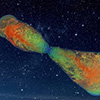| Jun 05, 2023 |
|
|
|
(Nanowerk News) So far, astrophysicists have only detected gravitational waves from binary systems — the mergers of either two black holes, two neutron stars or one of each. Although astrophysicists theoretically should be able to detect gravitational waves from a single, non-binary source, they have yet to uncover these elusive signals.
|
|
Now Northwestern University researchers suggest looking at a new, unexpected and entirely unexplored place: The turbulent, energetic cocoons of debris that surround dying massive stars.
|
|
For the first time ever, the researchers have used state-of-the-art simulations to show that these cocoons can emit gravitational waves. And, unlike gamma-ray burst jets, cocoons’ gravitational waves should be within the frequency band that the Laser Interferometer Gravitational-Wave Observatory (LIGO) can detect.
|
|
“As of today, LIGO has only detected gravitational waves from binary systems, but one day it will detect the first non-binary source of gravitational waves,” said Northwestern’s Ore Gottlieb, who led the study. “Cocoons are one of the first places we should look to for this type of source.”
|
|
Gottlieb will present this research during a virtual press briefing at the 242nd meeting of the American Astronomical Society. “Jetted and turbulent stellar deaths: New LIGO-detectable sources of gravitational waves” will take place at 12:15 p.m. EDT on Monday, June 5, as a part of a session on “Discoveries in Distant Galaxies.”
|
|
Gottlieb is a CIERA Fellow at Northwestern’s Center for Interdisciplinary Exploration and Research in Astrophysics (CIERA). Northwestern co-authors of the study include professors Vicky Kalogera and Alexander Tchekovskoy, postdoctoral associates Sharan Banagiri and Jonatan Jacquemin-Ide and graduate student Nick Kaaz.
|
 |
| As a jet escapes from a collapsed star, it punches into a cocoon of stellar debris. (Image: Ore Gottlieb / CIERA / Northwestern University)
|
New source was ‘impossible to ignore’
|
|
To conduct the study, Gottlieb and his collaborators used new state-of-the-art simulations to model the collapse of a massive star. When massive stars collapse into black holes, they may create powerful outflows (or jets) of particles traveling close to the speed of light. Gottlieb’s simulations modeled this process — from the time the star collapses into a black hole until the jet escapes.
|
|
Initially, he wanted to see whether or not the accretion disk that forms around a black hole could emit detectable gravitational waves. But something unexpected kept emerging from his data.
|
|
“When I calculated the gravitational waves from the vicinity of the black hole, I found another source disrupting my calculations — the cocoon,” Gottlieb said. “I tried to ignore it. But I found it was impossible to ignore. Then I realized the cocoon was an interesting gravitational wave source.”
|
|
As jets collide into collapsing layers of the dying star, a bubble, or a “cocoon,” forms around the jet. Cocoons are turbulent places, where hot gases and debris mix randomly and expand in all directions from the jet. As the energetic bubble accelerates from the jet, it perturbs space-time to create a ripple of gravitational waves, Gottlieb explained.
|
|
“A jet starts deep inside of a star and then drills its way out to escape,” Gottlieb said. “It’s like when you drill a hole into a wall. The spinning drill bit hits the wall and debris spills out of the wall. The drill bit gives that material energy. Similarly, the jet punches through the star, causing the star’s material to heat up and spill out. This debris forms the hot layers of a cocoon.”
|
Call to action to look at cocoons
|
|
If cocoons do generate gravitational waves, then LIGO should be able to detect them in its upcoming runs, Gottlieb said. Researchers have typically searched for single-source gravitational waves from gamma-ray bursts or supernovae, but astrophysicists doubt that LIGO could detect those.
|
|
“Both jets and supernovae are very energetic explosions,” Gottlieb said. “But we can only detect gravitational waves from higher frequency, asymmetrical explosions. Supernovae are rather spherical and symmetrical, so spherical explosions do not change the balanced mass distribution in the star to emit gravitational waves. Gamma-ray bursts last dozens of seconds, so the frequency is very small — lower than the frequency band that LIGO is sensitive to.”
|
|
Instead, Gottlieb asks astrophysicists to redirect their attention to cocoons, which are both asymmetrical and highly energetic.
|
|
“Our study is a call to action to the community to look at cocoons as a source of gravitational waves,” he said. “We also know cocoons to emit electromagnetic radiation, so they could be multi-messenger events. By studying them, we could learn more about what happens in the innermost part of stars, the properties of jets and their prevalence in stellar explosions.”
|


